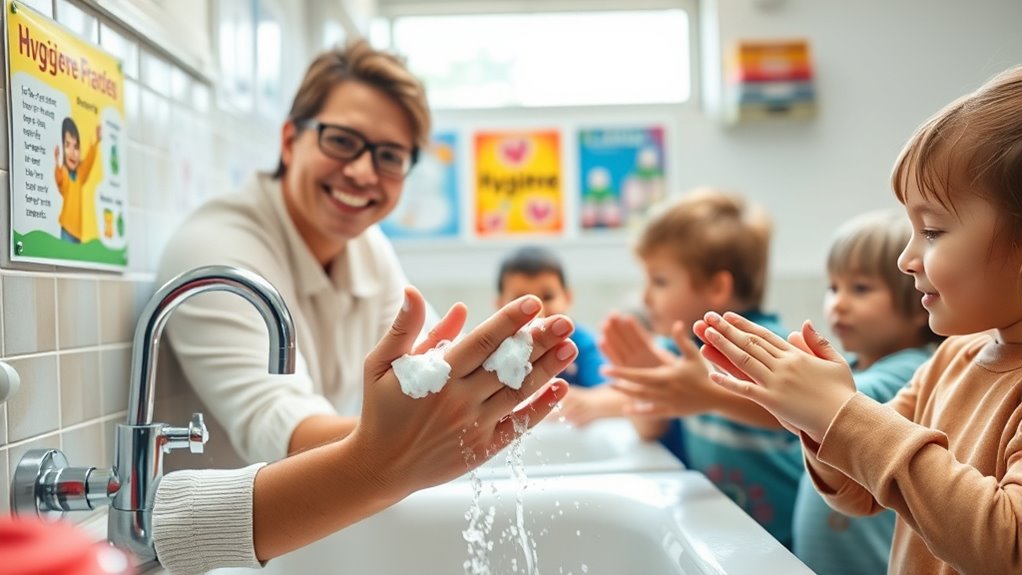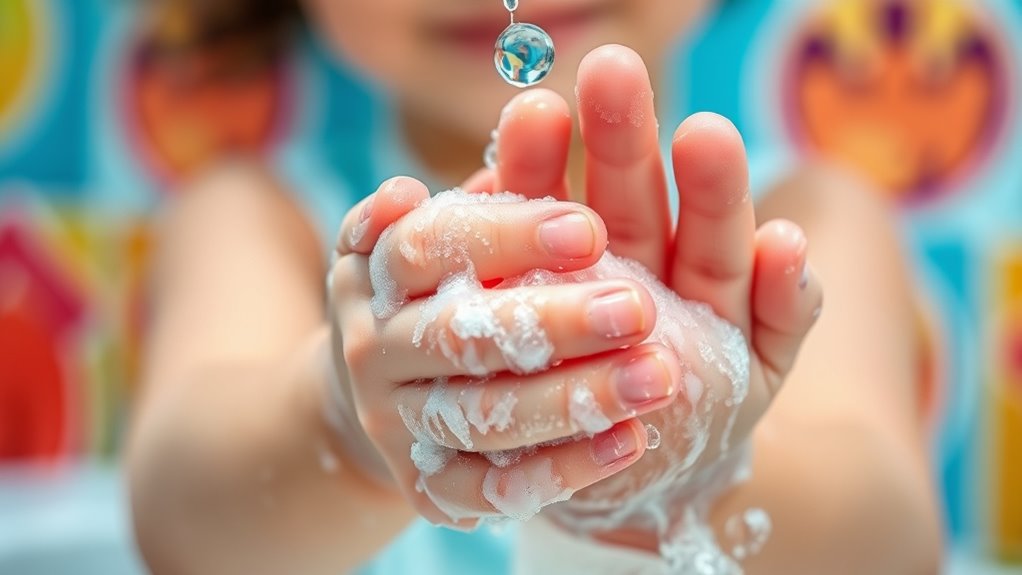To teach handwashing that sticks, make it engaging, visual, and memorable. Use colorful posters, catchy rhymes, and demonstrations that show all hand surfaces. Incorporate fun elements like stories, videos, or challenges to motivate learners. Repeat the steps often and use cues such as signs or reminders to build habits. Encouraging community involvement and leveraging social media trends can reinforce the practice long-term. Keep exploring for more effective techniques to make handwashing truly stick.
Key Takeaways
- Use engaging visuals, catchy slogans, and interactive demonstrations to make handwashing memorable.
- Teach the 20-second technique with clear steps and visual aids to ensure proper practice.
- Incorporate fun elements like games, rhymes, or challenges to reinforce habit formation.
- Leverage social media trends and community involvement to motivate consistent hand hygiene.
- Reinforce routines with reminders, signs, and peer influence to embed handwashing as a daily habit.

Have you ever wondered how simple handwashing can prevent the spread of illness? It’s one of the most effective ways to protect yourself and others from viruses, bacteria, and other germs. Sadly, many people underestimate its power, especially when viruses are spreading rapidly through viral challenges and outbreaks. That’s why teaching handwashing that sticks is essential. When you implement engaging hand hygiene campaigns, you can turn a basic habit into a lifelong practice. These campaigns help raise awareness, motivate action, and reinforce proper techniques. They often include colorful posters, interactive demonstrations, and catchy slogans that resonate with different age groups. The goal is to make handwashing memorable, so it becomes second nature, even amidst the chaos of a viral challenge or during flu season.
To truly make an impact, you need to go beyond just telling people to wash their hands. Incorporate fun and relatable elements into your messaging. Show how germs can cling to unwashed hands and spread easily from person to person. Use visuals and stories that highlight real-life consequences, making the importance of hand hygiene concrete. When you involve community leaders or influencers in your campaigns, you amplify your message and reach wider audiences. This not only boosts participation but also normalizes handwashing as a critical health habit. During viral challenges, for instance, you can leverage social media trends by encouraging people to share videos of their handwashing routines. This creates a ripple effect, motivating others to follow suit and reinforcing the message through peer influence.
Another key to successful teaching is ensuring the technique is correct. Stress the importance of washing for at least 20 seconds, covering all surfaces of the hands—fronts, backs, between fingers, and under nails. Demonstrate proper handwashing steps clearly and repeatedly. Use visual aids or catchy rhymes to make it easy to remember. Remember, consistency is key. Repetition solidifies learning, especially when you’re competing with the quick pace of viral challenges that often prioritize instant gratification. Incorporating proper technique and regular practice ensures that the habit sticks. Incorporate reminders into daily routines, like placing signs near sinks or giving out reminder cards during health fairs.
Ultimately, teaching handwashing that sticks involves making it relevant, engaging, and easy to do. When you combine the power of viral challenges and targeted hand hygiene campaigns, you create an environment where good habits flourish. It’s not just about preventing illness today; it’s about instilling lifelong practices that keep everyone healthier tomorrow. By doing so, you’re not only fighting germs but also fostering a culture of health awareness that can withstand any viral threat.
Frequently Asked Questions
How Can I Motivate Children to Wash Hands Regularly?
You can motivate children to wash their hands regularly by using creative rewards like stickers or extra playtime to reinforce the habit. Peer modeling works well too; when kids see their friends practicing good hand hygiene, they’ll want to join in. Make handwashing fun and engaging, and praise their efforts. This positive reinforcement encourages consistent habits and helps children understand the importance of cleanliness.
What Are Effective Ways to Correct Improper Handwashing Techniques?
You can correct improper handwashing techniques by using positive reinforcement when kids do it correctly, praising their effort and progress. Additionally, encourage peer modeling by having children watch and imitate their classmates who demonstrate proper handwashing. Gently guide those struggling, offering clear demonstrations and friendly reminders. Consistently reinforcing good habits and leveraging peer influence make correcting techniques effective and help children develop lifelong skills.
How Do Cultural Differences Influence Handwashing Habits?
You might not realize it, but cultural rituals and hygiene perceptions deeply shape how you wash your hands. These differences can influence the methods, timing, and importance you attribute to hand hygiene. Some cultures emphasize ritualistic cleansing, while others see it as a practical task. Recognizing these variations helps you understand why habits vary worldwide and how you can adapt or improve your own practices to ensure better health for everyone.
What Are the Signs of Poor Hand Hygiene in Children?
You’ll notice signs of negligence in children, like persistent dirt on their hands or unclean fingernails, which are clear hygiene indicators. They might also frequently touch their face or refuse to wash hands altogether. Foul odors, visible germs, or skin irritations can also signal poor hand hygiene. Keep an eye out for these signs to address hygiene issues early and encourage better handwashing habits.
How Can Technology Be Used to Teach Handwashing?
You can use digital games and interactive apps to make handwashing fun and memorable for kids. Imagine a game where they help characters wash away germs or track their progress with colorful animations. These tools engage children actively, turning handwashing into an exciting activity. By integrating technology, you create a visual and interactive experience that reinforces proper techniques, making good hygiene habits stick effortlessly in their minds.
Conclusion
Now, imagine the comforting warmth of soap bubbles swirling around your fingertips, the gentle hum of water rinsing away germs, and the clean, fresh scent lingering on your skin. When you teach handwashing with enthusiasm, those little moments become memorable. You’re not just washing hands — you’re creating a habit that shields you from illness. Keep the routine lively and fun, so it sticks as naturally as your favorite song, keeping everyone healthy and happy.









